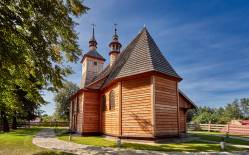All Saints Parish in Siennów was established in 1390. In the 1500s, the church like many others in southern Poland, was transformed for the needs of Calvinists. It was reinstated as a Roman Catholic church in 1637.
The present church was founded by Maria Ożarowska, owner of the village, in 1676. During reconstruction works, presumably carried out in 1869, the wide skirt roof was dismantled. At that time a vestibule was also added on the western side of the nave.
The building was seriously damaged in August 1999 when an oak tree fell on the structure and partly destroyed the chancel and the sacristy; the walls of the church were tilted and displaced with respect to the foundations. Repairs were initiated the same year, and included reconstruction of rafter framing, ceiling and the brick gable wall in the sacristy.
The church is not oriented eastward. The structure comprises a chancel, and a slightly wider nave with a vestibule. On the northern side the chancel is adjoined by the sacristy. The chancel and the nave are covered with a single gable roof; over the vestibule the roof is lower. On the ridge of the roof over the nave we can see a bell turret.
The church is a log structure. Underneath the brick sacristy there is a basement. The rectangular windows in the nave and the chancel are enclosed with segmental arches; in the vestibule there are two semi-circular windows.
The interior furnishings, including the high altar and the side altars, as well as a baptismal font, date from the 1700s.
On the southern side of the church there is a brick zvonnitsa-type belfry.
In the village there are also remnants of a manorial estate, comprising a brick outbuilding with a porch supported on two pillars (1700s), a park (1700s) which was redesigned into a landscaped park in the 1800s, as well as relics of ramparts dating from the 1600s.
Photo: Krystian Kłysewicz
Gallery

Recommended venues on the Trail



This website has been modernized with the financial support of the European Union under the Cross-Border Cooperation Programme Poland-Belarus-Ukraine 2014-2020. The responsibility for its content lies solely with the Podkarpackie Regional Tourism Board and cannot, in any case, be treated as a reflection of the position of the European Union, the Managing Authority, or the Joint Technical Secretariat of the Cross-Border Cooperation Programme Poland-Belarus-Ukraine 2014-2020.













